Kirchhofs Law (English)
In 1845, Gustav Kirchoff published two rules related to voltage and current in electric circuits. These two rules are jointly called the rules of Kirchoff's circuit.
1. Kirchhoff's current / circuit laws (KCL)
2. Kirchhoff's Voltage laws (KVL)
1. Kirchhoff's current / circuit laws (KCL)
(The current entering any junction is equal to the current leaving that junction.)
The sum of the currents leading to a node or janxan is equal to the sum of the currents going away from that node; That is,
i1 + i4 = i2 + i3
This rule is called the 'Rule of Kirchoff', 'Rule of Kirchoff', 'Rule of Kirchoff's Judgment', and Kirchoff's First Law.
n is the total number of section-branches related to a node.
This rule is also true for the common currents.
This rule is based on the rule of protection of charge.
2. Kirchhoff's Voltage laws (KVL)

(The sum of all the voltages around a loop is equal to zero.)
The backbone of a hoop: All the algorithms have algebraic yoga;
That is,
v1 + v2 + v3 + v4 = 0
This rule is also called 'Kirchoff's second law or Kirchoff's Loop's law.
T BACK OF A CORD (loop): The algebraic sum of all the differences is zero.
That is,
Here, n is located in the loop, which is equal to the number of possible distances. These possible possible numbers (such as in the case of AC analysis) may also occur.
This rule is based on the rule of energy conservation.








Comments
Post a Comment